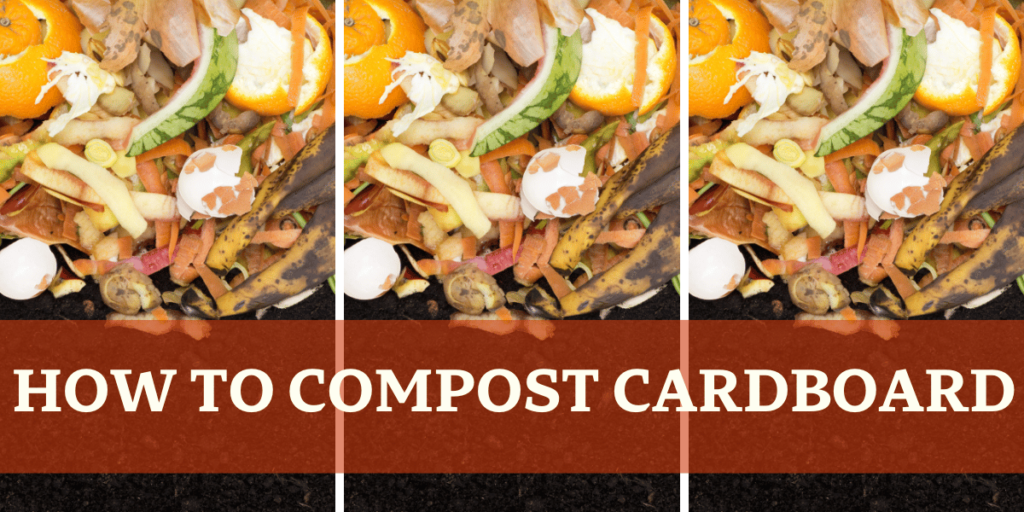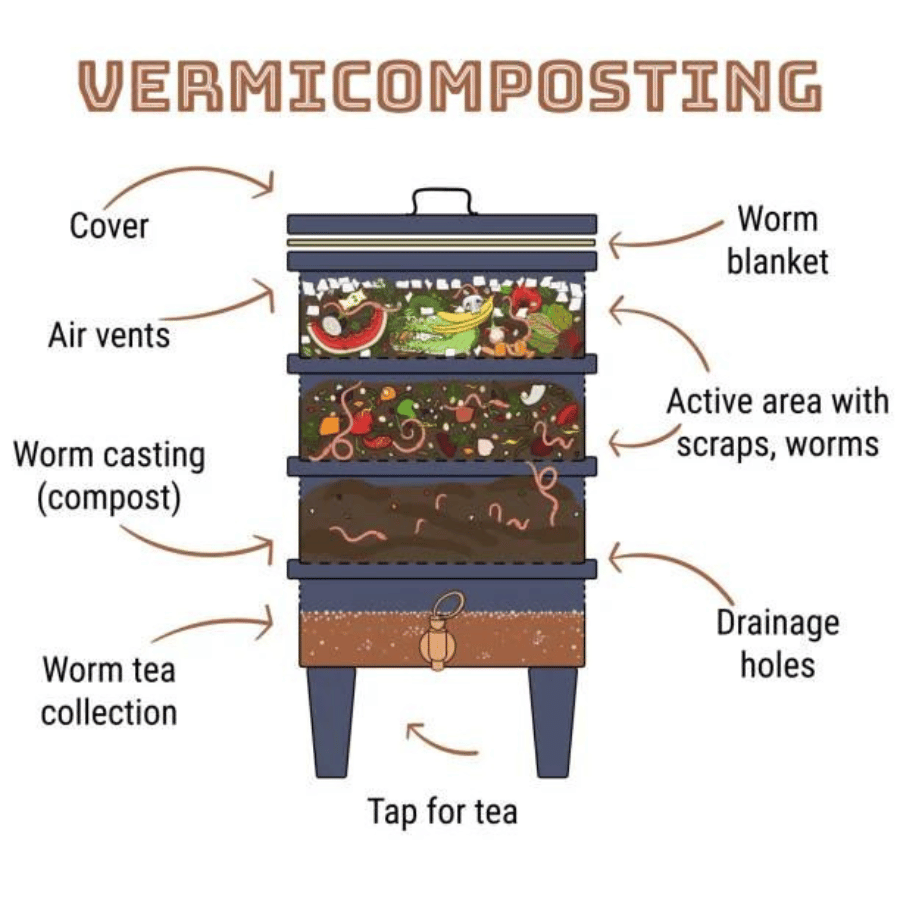
Let’s learn how to compost cardboard!
Did you know that your household cardboard, such as empty cereal boxes, toilet paper rolls, egg boxes, and pizza boxes, can play a pivotal role in your compost pile?
This comprehensive guide will walk you through the essential steps to effectively compost cardboard, demonstrating how it can become an eco-friendly addition to your compost bin or heap.
Whether you’re just starting out on your composting journey or consider yourself an expert composter, you’ll gain valuable insights into utilizing cardboard for composting, thereby transforming waste materials into nutrient-rich compost to nourish your garden and promote sustainable gardening practices.
This Post Is All About How to Compost Cardboard
What is Composting?
Composting is a natural process that transforms organic materials into rich soil-like substance known as compost.
This decomposition process involves microorganisms breaking down organic matter, such as food waste, garden waste, and yes, even cardboard.
The result is nutrient-rich compost that improves soil quality and supports plant growth.
The Science Behind Composting
Understanding the science of composting can help you optimize your compost pile.
Microorganisms like bacteria and fungi are the primary decomposers. They break down organic matter into smaller pieces, releasing heat in the process. This heat accelerates decomposition and kills harmful pathogens.
Properly managed compost piles can reach temperatures of up to 70°C (160°F), ensuring a safe and efficient composting process.
Main Ingredients for Composting

Brown Materials (Carbon)
Brown or high-carbon materials, such as dried leaves, straw, and cardboard, are abundant in carbon.
This carbon-rich composition serves as a valuable energy source for microorganisms within the compost, aiding in the sustenance of a harmonious and well-rounded compost mix.
Green Materials (Nitrogen)
Green materials, such as nitrogen-rich food scraps, grass clippings, and kitchen waste, play a vital role in composting.
These organic components provide essential proteins that support the growth and activity of decomposers, contributing to the breakdown process and enriching the soil with valuable nutrients.
By utilizing these green materials effectively, composters can create a nutrient-rich environment that benefits the overall health and fertility of their gardens or composting systems.
Air and Moisture (Oxygen)
Sufficient airflow and moisture levels are vital components in ensuring the optimal conditions for decomposition.
Adequate aeration plays a critical role in preventing the accumulation of excess moisture, which, in turn, facilitates the formation of air pockets that are essential for promoting the aerobic decomposition process.
Benefits of Using Cardboard in Composting
Eco-Friendly Recycling
Composting cardboard is an effective practice that not only reduces landfill waste but also plays a crucial role in lowering methane emissions, a potent greenhouse gas.
When we compost cardboard instead of throwing it in landfills, we help the environment by managing paper and cardboard better. This supports conservation and reduces waste.
Soil Enrichment
Cardboard is a beneficial addition to your compost mix as it contributes carbon, which helps in balancing nitrogen-rich materials.
This harmonious blend leads to the creation of nutrient-rich compost that not only enriches the soil but also promotes healthier plant growth in your garden.
Weed Suppression
By incorporating cardboard as a layer in your compost heap or garden, you can effectively suppress weeds.
This method not only aids in maintaining the health of your native lawns and plants, but also assists in retaining moisture in the soil, promoting better growth and overall plant vitality.
Different Types of Cardboard for Composting
Shredded Cardboard
To expedite the composting process, shredded cardboard is highly effective due to its quick breakdown.
Consider using a paper shredder for convenience or manually tear the cardboard into smaller pieces, promoting faster decomposition and nutrient release in your compost pile.
This simple yet efficient method can significantly enhance the overall composting experience.
Cereal Boxes and Egg Cartons
These materials are excellent sources of brown materials for composting.
It’s crucial to check that they are free from any shiny cardboard coatings or toxic inks, as these can affect the quality of the compost and the health of the soil.
Ensuring the materials are clean and natural will contribute to a more effective composting process and result in nutrient-rich soil for your garden.
Toilet Paper Rolls and Paper Towel Rolls
These items can be effortlessly cut into smaller pieces, making them more manageable for inclusion in your compost pile.
This practice not only aids in decomposition but also promotes nutrient-rich soil for your garden or plants to thrive in.
Composting Methods for Cardboard
Traditional Compost Pile
When building your compost pile, ensure to include a mix of green and brown materials for optimal decomposition.
Green materials like kitchen scraps provide nitrogen, while brown materials such as shredded cardboard offer carbon.
Turning the pile regularly helps maintain airflow, creating an ideal environment for decomposition to occur efficiently.
Compost Bin
A compost bin plays a crucial role in managing compost effectively by containing the organic materials and aiding in the decomposition process.
By adding in kitchen scraps, such as fruit and vegetable peels, with cardboard or paper, you create a balanced environment that promotes the breakdown of organic matter into nutrient-rich compost.
This simple practice not only reduces waste but also produces a valuable resource for enriching your garden soil.
Worm Bin

Red wigglers, a type of earthworm species known scientifically as Eisenia fetida, are highly beneficial for vermicomposting due to their voracious appetite for organic waste materials, such as fruit and vegetable scraps, coffee grounds, and even cardboard.
These composting champions not only help break down waste efficiently but also enrich the resulting compost with valuable nutrients that are beneficial for plants.
When creating a vermicomposting bin for red wigglers, it is essential to maintain proper moisture levels by ensuring the bedding remains damp but not overly saturated, as excess water can lead to anaerobic conditions detrimental to the worms’ health.
Lasagna Method
The lasagna method for composting cardboard involves layering shredded cardboard with other organic materials, such as food scraps and leaves, to create a nutrient-rich compost pile.
This allows the cardboard to break down more easily and efficiently, resulting in a healthier compost for your garden.
Improving Your Compost with Cardboard
Balancing Carbon and Nitrogen
Excess cardboard in a compost pile can hinder the decomposition process, leading to a slower breakdown of materials. To optimize composting efficiency, it is recommended to balance the cardboard with nitrogen-rich elements such as food scraps and green garden waste.
By incorporating a mix of carbon-rich (like cardboard) and nitrogen-rich components, you create a more balanced environment for beneficial microorganisms to thrive and accelerate the composting process.
Ensuring Adequate Aeration
Large pieces of cardboard can obstruct the airflow within compost piles. To enhance aeration and facilitate the decomposition process, it is advisable to shred or cut the cardboard into smaller pieces before adding them to the compost bin.
This practice will help create air channels, allowing oxygen to reach the microorganisms responsible for breaking down organic matter efficiently.
Monitoring Moisture Levels
Cardboard plays a crucial role in maintaining the optimal moisture levels in your compost heap. By absorbing excess moisture, it helps prevent the compost from turning overly wet, which can hinder the decomposition process.
It’s important to adjust the amount of cardboard based on the current moisture level of your compost to ensure it remains balanced and effective in supporting the composting environment.
Common Problems and Solutions
Excess Moisture
If you find that your compost is overly wet, consider incorporating additional shredded cardboard or other dry brown materials into the mix.
These materials serve to effectively absorb excess moisture, aiding in restoring the optimal balance required for successful composting.
Slow Decomposition
If the decomposition process is progressing slowly, it’s advisable to assess the equilibrium between green and brown materials in the mix.
Consider supplementing with additional nitrogen-rich materials or aerating the pile through turning to expedite the composting process.
This proactive approach can help maintain optimal conditions for decomposition and enhance the overall efficiency of the compost pile.
Unpleasant Odors
To address odors emanating from your compost pile, which typically indicate anaerobic conditions, consider implementing a few steps.
Firstly, ensure you turn the compost pile regularly to promote aeration and prevent the build-up of trapped gases.
Secondly, adding dry materials such as straw, leaves, or shredded newspaper can help balance moisture levels and improve airflow within the pile.
Lastly, maintaining proper aeration throughout the composting process will not only reduce unpleasant smells but also support the decomposition of organic matter effectively.
The Environmental Impact of Composting Cardboard
Composting cardboard is a fantastic way to decrease your carbon footprint and play a part in environmental sustainability efforts.
By diverting cardboard waste from landfills, you contribute to reducing harmful methane emissions and support the development of a circular economy.
This simple yet impactful action not only benefits the environment but also sets the stage for a more sustainable and eco-friendly future in Canada.
Frequently Asked Questions
Is it ok to compost your cardboard boxes?
Yes, cardboard boxes are indeed safe to compost in your garden. It’s crucial to make sure they are free from any toxic inks or shiny coatings that could potentially harm your composting process.
By confirming the absence of these substances, you can be confident that your compost will remain healthy and effective for your garden’s needs.
How long does it take for cardboard to compost?
When adding shredded cardboard to your compost, keep in mind that it typically takes a few months to decompose fully.
Larger cardboard pieces may require a longer decomposition period. To expedite the process, consider turning your compost pile on a regular basis, aiding in the breakdown of materials and promoting efficient decomposition.
What are the best ways to compost cardboard?
Shredding cardboard into small pieces before layering it with green materials like grass clippings, vegetable scraps, or coffee grounds in your compost pile or bin can significantly aid in efficient decomposition.
Additionally, vermiculture, specifically using red wigglers, is a highly effective method to accelerate the composting process while enriching the soil with valuable nutrients.
Conclusion
Composting cardboard is an eco-conscious way to recycle and enrich your garden soil. By understanding the science of composting and following this comprehensive guide, you can turn cardboard waste into valuable compost. Start composting today and contribute to a sustainable, greener world. For personalized advice, feel free to reach out to our team of experts.
